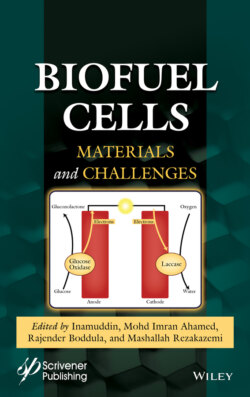Читать книгу Biofuel Cells - Группа авторов - Страница 20
1.4.2 Carbon Paper Bioelectrodes for BFCs
ОглавлениеTorrinha et al. used a typical methodology reported for buckypaper to prepare paper-like electrodes using Vulcan carbon black, reduced graphene (rG) electrode and carbon nanotubes (buckypaper electrode) [106]. Glucose oxidase and bilirubin oxidase were deposited onto these electrodes, and a finger-powered glucose biofuel cell was constructed. This cell has the advantage of avoiding the use of external pumps to drive the anodic and cathodic streams, using the finger force for that purpose. The authors found that paper-like electrode of rG outperformed buckypaper and Vulcan carbon black paper-like electrodes. Escalona-Villalpando et al. evaluated the use of nanofoam-like carbon paper in hybrids bioanode/cathode & anode/biocathode glucose nanofluidic BFCs and in a full glucose nanofluidic BFC [107]. The authors found that the OCV in the glucose oxidase & Pt/C hybrid BFC was 0.55 V, and it can be increased to 0.91 V using a AuAg anode with a laccase biocathode. In addition, the full BFC achieved 0.44 V and a maximum power density of 3.2 mW cm−2. Escalona-Villalpando et al. also reported the effect of stacked microfluidic biofuel cells on the power density. For this purpose, they worked with glucose dehydrogenase as anodic biocatalyst and bilirubin oxidase as cathodic biocatalyst [108]. A single cell BFC enabled 0.78 V and 0.36 mW cm−2, while four cells stacked in parallel achieved 0.53 mW cm−2, and these cells stacked in series enabled an OCV of 1.27 V and a power density of 0.38 mW cm−2. However, the most effective way that they found to improve the cell performance was stacking four cells 1 and 2 in series and 3 and 4 in parallel, achieving an OCV of 1.23 and a power density of 0.42 mW cm−2.
Another kind of carbon paper electrodes consisted in carbon fiber arrays; Koushanpour et al. developed an all glucose biofuel cell using this electrode and the H2O2 generated in the anode as oxidant [109]. They reported that the use of Meldola’s blue as catalyst for the electro-oxidation of NADH and hemin as catalyst for H2O2 reduction resulted in OCVs close to 0.5 V.
